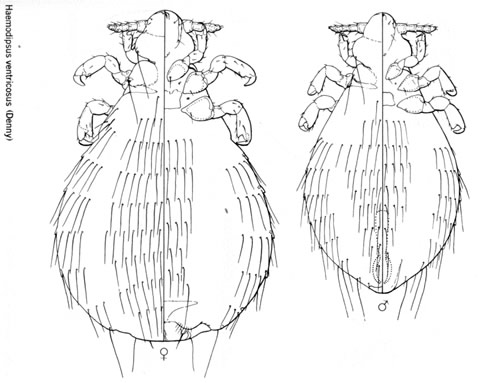Etiology: Haemodipsus ventricosus is the blood-sucking louse of rabbits.
Incidence: Incidence of infection is rare. Lice are generally species-specific.
Transmission: Transmission occurs by direct contact.
Distribution: Lice are distributed on dorsal and lateral surfaces of the body and the pelvic area.
Clinical Signs: Clinical signs include rough hair coat, extreme pruritis, weakness, and anemia leading to severe debilitation. This louse is a vector of tularemia.
Diagnosis:
Antemortem
1. Pluck or brush hairs and examine subgrossly (dissecting microscope) or microscopically for lice or eggs.
2. Run cellophane tape against the grain of the fur, place on a slide and examine microscopically for lice or their eggs.
Postmortem
1. Place pelage (fur) samples collected. As the pelage cools, lice will migrate towards the tips of the hair shafts and be visible with a dissecting microscope.
2. Place pelage samples on black construction paper. As the pelt cools, the lice will crawl away, and be visible as white specks on the black background. *Be sure to ring the edges of the construction paper with double stick tape, so that the lice do not escape the area.
These lice are Anoplurans (blood-suckers) and so may be blood-engorged.
Diagnostic Morphology: Lice have a large oval abdomen, small head, and numerous long hairs on the dorsal and ventral surfaces. Anopluran lice are generally dusky gray in color unless blood-engorged [3].
